“Global Laboratory Robotics Market to reach a market value of USD 2.6 Billion by 2031 growing at a CAGR of 6.9%”
The Global Laboratory Robotics Market size is expected to reach $2.6 billion by 2031, rising at a market growth of 6.9% CAGR during the forecast period.
Robotic arms automate complex and repetitive tasks that require precise manipulation and control. These tasks may include transferring samples between different instruments, conducting intricate assembly processes, or performing delicate surgical procedures in biomedical research and clinical applications. In 2023, the robotic arms segment held 12% revenue share in the market. Robotic arms seamlessly integrate with other laboratory automation systems, such as liquid-handling robots, plate handlers, and imaging platforms. This integration streamlines workflow continuity by automating sequential tasks and data transfer between interconnected instruments, optimizing operational efficiency and experimental throughput.
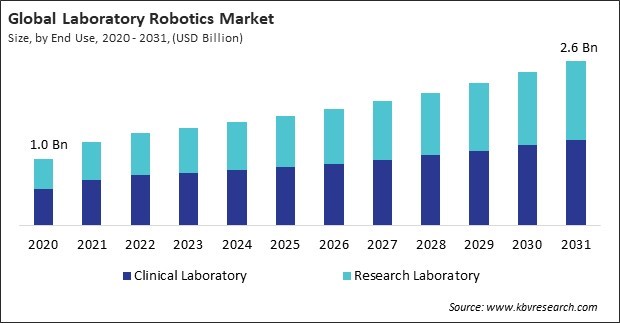
The major strategies followed by the market participants are Product Launches as the key developmental strategy to keep pace with the changing demands of end users. For instance, in February, 2024, Thermo Fisher Scientific Inc. unveiled the Thermo Scientific Dionex Inuvion Ion Chromatography (IC) system, simplifying ion analysis for labs of all sizes. This new instrument is highly configurable, offering a comprehensive solution for precise detection of ionic and small polar compounds, ensuring reliable results consistently. Additionally, in November, 2023, Thermo Fisher unveiled the Thermo Scientific ARL iSpark Plus Optical Emission Spectrometer series, aiming to enhance elemental analysis in metal industries, including production, processing, recycling, and labs.
Based on the Analysis presented in the KBV Cardinal matrix; Thermo Fisher Scientific Inc. and Abbott Laboratories are the forerunners in the Laboratory Robotics Market. In March, 2024, Abbott unveiled GLP Systems Track, a new automation solution for laboratories, designed to meet high-volume demands while optimizing resource use and maintaining quality care. Companies such as Danaher Corporation, Siemens Healthineers AG, PerkinElmer, Inc. are some of the key innovators in Laboratory Robotics Market.
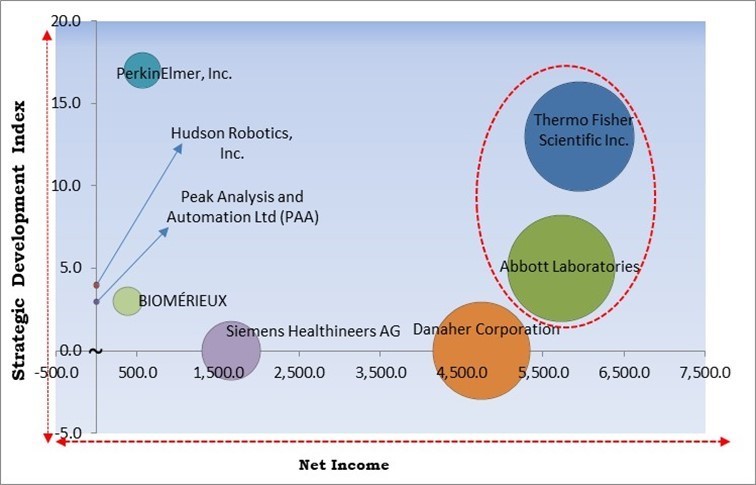
The pandemic disrupted global supply chains, causing delays in manufacturing and delivering laboratory robotics components and systems. This resulted in shortages and increased lead times for robotics equipment, hindering market growth and deployment. Economic uncertainties during the pandemic led many healthcare institutions, research laboratories, and pharmaceutical companies to reduce capital expenditures. This uncertainty in healthcare funding and financial planning further restrained investments in laboratory robotics infrastructure and technology upgrades. Thus, the COVID-19 pandemic had a negative impact on the market.
Automation reduces the time and effort required for routine tasks such as sample handling, preparation, and analysis. Robotic systems can perform these tasks consistently and with higher throughput than manual methods, thereby increasing overall laboratory efficiency. Robotics systems can execute tasks with high accuracy and precision, minimizing human error and variability. This is crucial in experiments requiring precise measurements, sample dispensing, and data collection, leading to more reliable experimental results. Thus, increasing automation in laboratories is driving the growth of the market.
HTS allows the rapid testing of thousands to millions of samples for biological activity, significantly speeding up drug discovery. Laboratory robots can handle large volumes of samples quickly and accurately, making them essential for HTS. Laboratory robotics ensures high precision and consistency in sample handling and processing, crucial for reliable HTS results. Manual handling of such many samples can introduce errors and variability. This makes HTS more economically feasible, encouraging its adoption and, consequently, the demand for laboratory robotics. Thus, demand for high throughput screening (HTS) drives the market's growth.
Purchasing laboratory robots and the associated equipment requires a substantial upfront capital investment. Many research institutions, particularly smaller labs and startups, may struggle to allocate the necessary funds for such high initial costs, limiting their ability to adopt robotics. Laboratory robots often require specialized infrastructure, such as dedicated lab spaces, power supplies, and compatible software systems. Upgrading existing facilities or constructing new ones to accommodate these needs can add to the overall costs, making it a barrier for some organizations. Therefore, high initial investment costs are hampering the growth of the market.
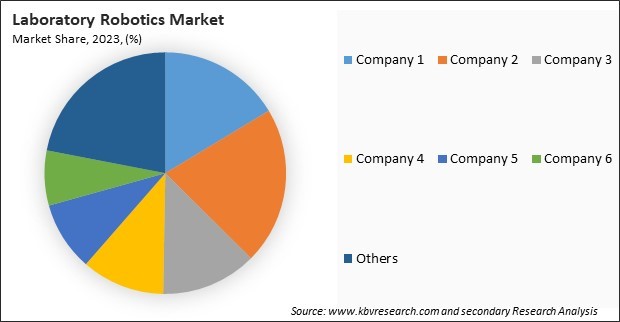
The leading players in the market are competing with diverse innovative offerings to remain competitive in the market. The above illustration shows the percentage of revenue shared by some of the leading companies in the market. The leading players of the market are adopting various strategies in order to cater demand coming from the different industries. The key developmental strategies in the market are Product Launches and Product Expansions.
Based on product, the market is divided into automated liquid handling robots, automated plate handlers, robotic arms, lab automation workstations, microplate readers & washers, and others. In 2023, the lab automation workstations segment garnered 36% revenue share in the market. Lab automation workstations significantly enhance laboratory efficiency by automating repetitive tasks such as sample preparation, liquid handling, and assay processing. Automated workflows reduce manual errors, improve consistency, and increase throughput, allowing laboratories to process larger samples in less time.
On the basis of application, the market is segmented into drug discovery, clinical diagnosis, microbiology solutions, genomics solutions, and proteomics solutions. In 2023, the clinical diagnosis segment garnered 22% revenue share in the market. Automated systems standardize diagnostic protocols and procedures across clinical laboratories, ensuring testing methodologies and result interpretation consistency. Standardization improves inter-laboratory comparability, reduces variability in diagnostic outcomes, and enhances the reliability of diagnostic testing for healthcare providers and patients.
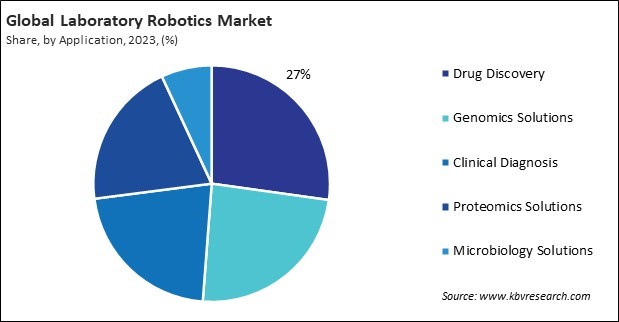
By end-use, the market is divided into clinical laboratory and research laboratory. In 2023, the clinical laboratory segment registered 54% revenue share in the market. Robotics facilitate integrating personalized medicine approaches into clinical practice by enabling the analysis of genetic markers, biomarkers, and therapeutic targets relevant to individual patient profiles. Automated systems support targeted therapies, pharmacogenomics testing, and disease stratification strategies, enhancing treatment efficacy and patient outcomes.
Free Valuable Insights: Global Laboratory Robotics Market size to reach USD 2.6 Billion by 2031
Region-wise, the market is analyzed across North America, Europe, Asia Pacific, and LAMEA. The North America region witnessed 40% revenue share in the market in 2023. North America boasts advanced healthcare infrastructure, including well-established clinical laboratories, research institutions, and pharmaceutical companies. These facilities prioritize technological innovation and automation to enhance diagnostic capabilities, research efficiency, and patient care outcomes.
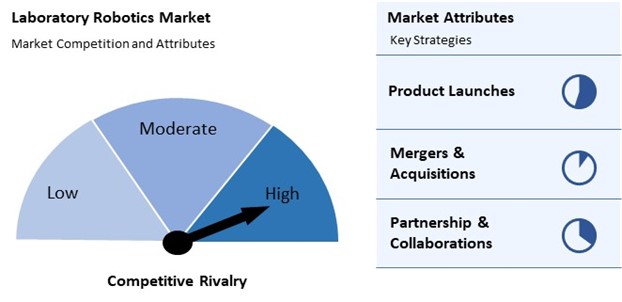
The Laboratory Robotics Market is characterized by intense competition driven by rapid technological advancements and increasing automation demands. Key players continuously innovate to enhance precision, efficiency, and integration capabilities of robotic systems. Major companies focus on strategic partnerships, mergers, and acquisitions to expand their product portfolios and global reach. Additionally, startups are entering the market with niche solutions, further intensifying the competitive landscape.
| Report Attribute | Details |
|---|---|
| Market size value in 2023 | USD 1.5 Billion |
| Market size forecast in 2031 | USD 2.6 Billion |
| Base Year | 2023 |
| Historical Period | 2020 to 2022 |
| Forecast Period | 2024 to 2031 |
| Revenue Growth Rate | CAGR of 6.9% from 2024 to 2031 |
| Number of Pages | 270 |
| Tables | 393 |
| Report coverage | Market Trends, Revenue Estimation and Forecast, Segmentation Analysis, Regional and Country Breakdown, Competitive Landscape, Market Share Analysis, Porter’s 5 Forces Analysis, Company Profiling, Companies Strategic Developments, SWOT Analysis, Winning Imperatives |
| Segments covered | Product, Application, End-Use, Region |
| Country scope |
|
| Companies Included | Peak Analysis and Automation Ltd (PAA), PerkinElmer, Inc., Thermo Fisher Scientific Inc., Hudson Robotics, Inc., Anton Paar GmbH, Danaher Corporation (Beckman Coulter, Inc.), Siemens Healthineers AG (Siemens AG), AB Controls, Inc., Abbott Laboratories, and BIOMÉRIEUX |
By End Use
By Application
By Product
By Geography
This Market size is expected to reach $2.6 billion by 2031.
Increasing Automation in Laboratories are driving the Market in coming years, however, High Initial Investment Costs restraints the growth of the Market.
Peak Analysis and Automation Ltd (PAA), PerkinElmer, Inc., Thermo Fisher Scientific Inc., Hudson Robotics, Inc., Anton Paar GmbH, Danaher Corporation (Beckman Coulter, Inc.), Siemens Healthineers AG (Siemens AG), AB Controls, Inc., Abbott Laboratories, and BIOMÉRIEUX
The expected CAGR of this Market is 6.9% from 2024 to 2031.
The Drug Discovery segment is leading the Market by Application in 2023; thereby, achieving a market value of $651 million by 2031.
The North America region dominated the Market by Region in 2023; thereby, achieving a market value of $988.4 million by 2031.
Our team of dedicated experts can provide you with attractive expansion opportunities for your business.

 Drivers
Drivers
 Restraints
Restraints
 Opportunities
Opportunities
 Challenges
Challenges
